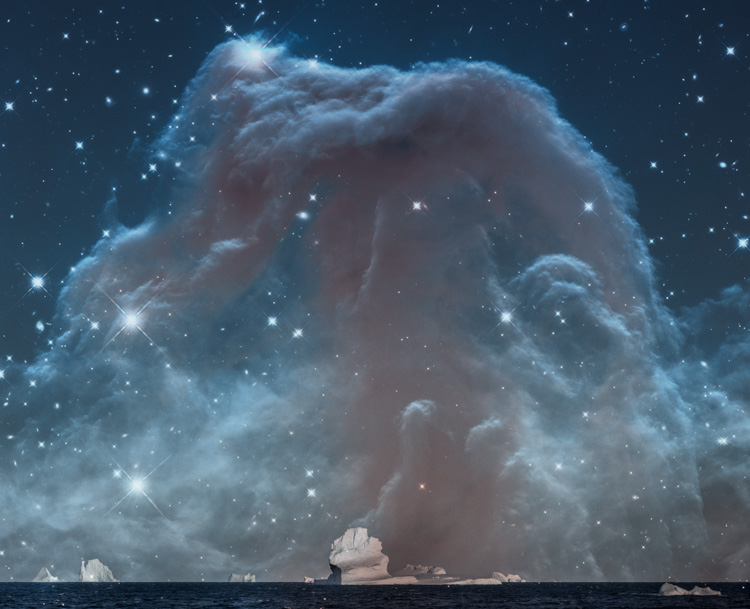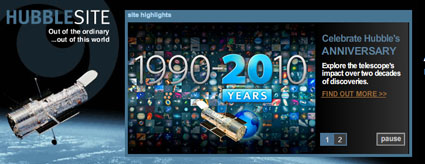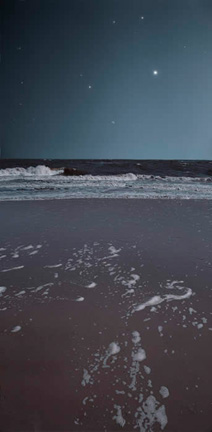Join Us Online Feb 3 – 5 For A Fabulous Night Photo Summit


Alignment XIV
My free October Desktop Calendar features an image from Death Valley, California.
Download your free copy here.
Find out more about this image here.
Nocturne / Correspondence XII, Newport, Rhode Island, 1999
While studying painting in college, I was given the assignment of painting night. After dark, I took my paint and canvas out into the night – and couldn’t see either. So I found a portable light source, which made them so bright that I couldn’t see beyond them. Next, I used a camera to make photographs to paint from and colors became distorted, and moving objects blurred or disappeared altogether. I ultimately ended up painting from memory, drawing on all of my accumulated memories from these attempts to make the final images.
Much later, working with digital imagery, I returned to this challenge. Wanting to avoid the distortions I had encountered before, I took a clue from Hollywood, shooting by day and color-adjusting those images to look like night. Realizing that the hard multi-colored points of light rendered by the camera eye did not look like what I saw with my naked I, I began digitally drawing stars as I saw them.
I found other people’s reactions to these images fascinating. Knowing that long exposures were necessary to make photographs in low light, photographers would ask me, “How did you get these exposures?” Familiar with the relative relationship of specific stars in the sky, astronomers would ask me, “Where did you find these constellations?” What each viewer knew changed the way they saw, the questions they asked, and their final reaction.
In order to see more, to see more deeply, and to see in more ways, I find myself constantly challenging what I think I know and striving to learn more in as many ways as I can think of.
How many ways does what you know help you make stronger images?
How many ways does what you know get in the way of your making stronger images?
How many ways can you increase the positive and reduce the negative impacts of what you know on your image-making?
“TED Fellow Lucianne Walkowicz asks: How often do you see the true beauty of the night sky? At TEDxPhoenix, she shows how light pollution is ruining the extraordinary — and often ignored — experience of seeing directly into space.
Lucianne Walkowicz works on NASA’s Kepler mission, studying starspots and “the tempestuous tantrums of stellar flares.”
Read 13 Essential Tips For Night & Low Light Photography here.
Learn more about night photography in my digital photography workshops.

“Hubble Site contains a gallery of images harvested from the famous telescope for over 20 years. Images are free to download in a variety of sizes. You’ll also find out how color is added to each of the images, which are originally captured in black and white.”
What child hasn’t spent scattered minutes, accumulated into hours or even days, watching slowly unfolding clouds and the changing sky? Wondering what they were, are, and will be. Imagining bodies (either whole or in pieces, especially faces), animals (whether commonplace, exotic, or mythical), plants, landscapes, and even mechanical devices. Who doesn’t pause at the sight of the blazing colors of the morning and evening sky? How few pause long enough to see the stars begin to appear? How strange to think that the same sky is blue by day and black by night, studded with twinkling stars. Are we like this too? Why do so many adults cease to probe these mysteries as consistently and frequently and with as much curiosity as a child does? What do we lose when we lose the search? Read More

I’ve always been fascinated by photographs of the night sky. Telescopes are able to bring back details I could never have seen with the naked eye. Film exaggerates the colors of the stars, which are faint to the human eye. The lens often eliminates the tiny flares we see. When we draw stars, we don’t use circles, we usually use pentagrams. There’s a reason. I can understand that the twinkle and shimmer of the tapestries above would disappear in a photograph. Time is frozen in photographs. But that the photograph would be significantly different than what the human eye sees is fascinating to me. We’re taught to think that the camera records things as we see them. It does to a degree. But there are many points of divergence. It’s almost standard for us to defer to the photograph over our own experience. That’s something I’m wary of — or let’s say instead, acutely aware of …
Read more here.